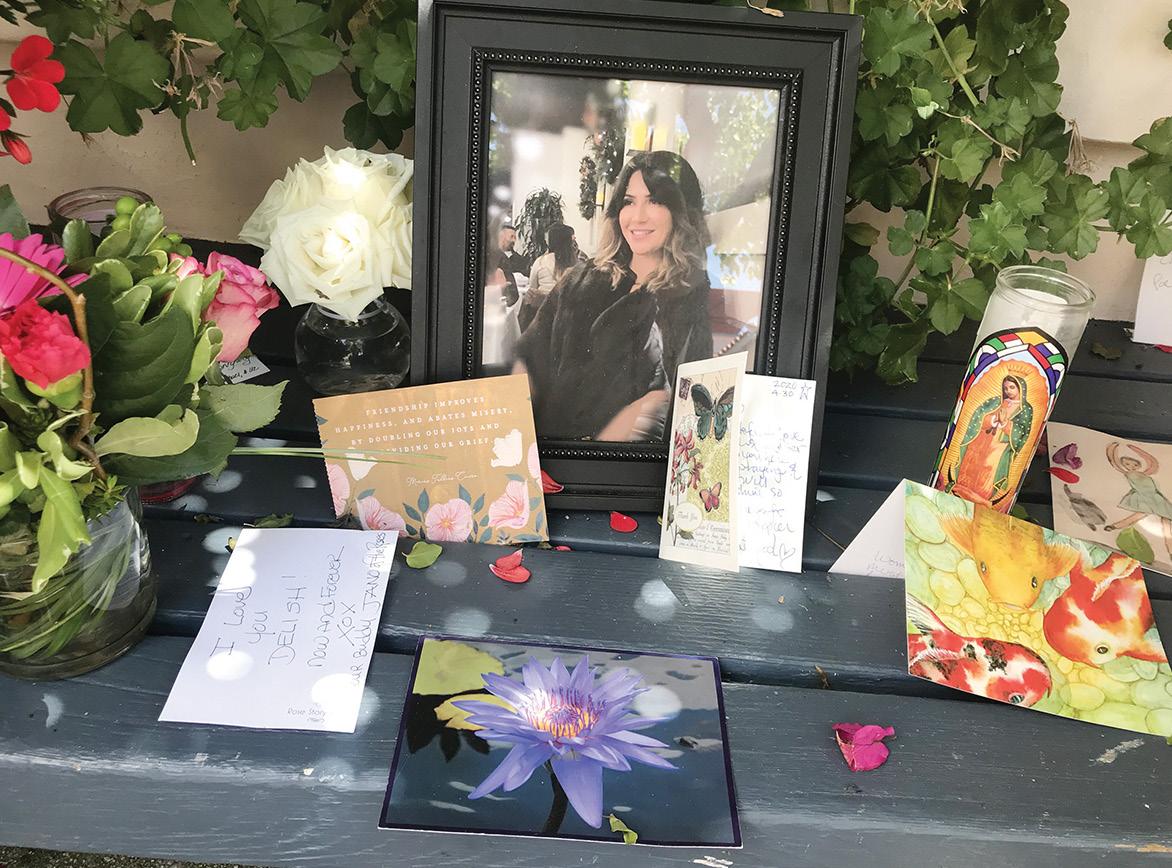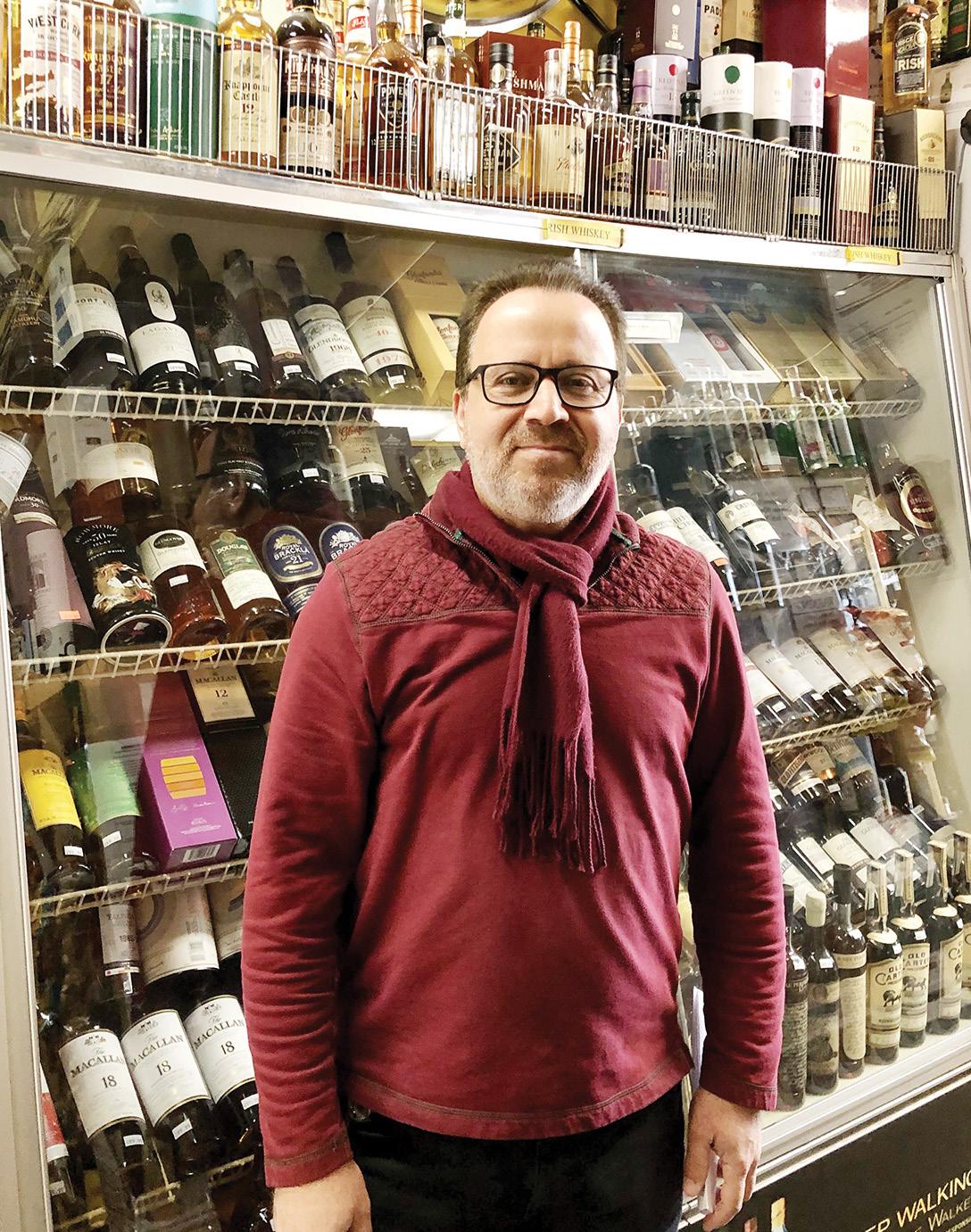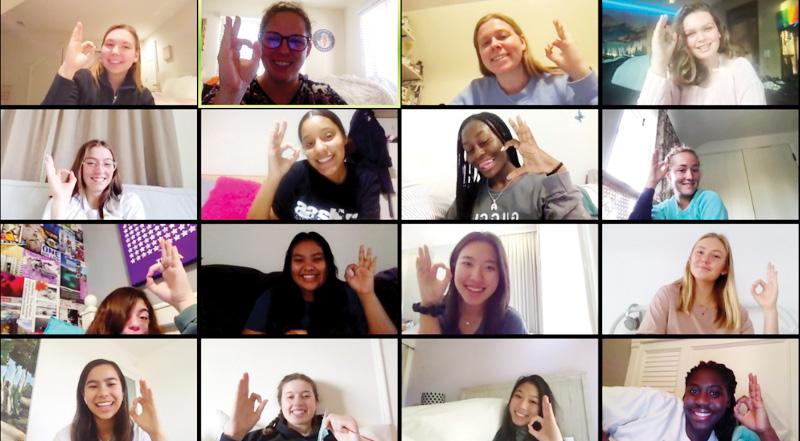
12 minute read
A Life to Remember
A Lesson in Loss: It’s important to tell those we love how much they mean to us – don’t wait.
Gretchen is founder and president of the Lutah Maria Riggs Society and Davey’s Voice, both Santa Barbara 501(c)(3) nonprofits. Gretchen sits on the board of the California Water Impact Network and is vice president of the board of the Santa Barbara
Wildlife Care Network. She is a former board member of the Granada Theatre and the Coral Casino Membership Committee.
It was another death along the train tracks in Montecito as we waited anxiously for further details and circumstances.
Then we heard it was a local hair stylist.
That was upsetting.
And then the unfathomable – 37-year-old Victoria Vaccarello, a vibrant local treasure, was the girl who lost her life along the tracks.
My friend Judy Foreman knew Victoria as an 11-year-old who used to play soccer with her daughter at Santa Barbara Middle School.
“After beauty school, Victoria worked at the Biltmore with Kevin Charles and then at Red Studio on Coast Village Road. She was a very good hairdresser – very responsible and a good friend to a lot of people,” Judy said.
“Did she do your hair?”
“No, but I would see her quite often at Salon Montecito, and I found her to be very professional. There was no sadness in her at all, she was a very independent person. She played hard and she worked hard, and she loved to travel. She would go to Europe and rent a car and drive around. But she was not a sad person, at all,” Judy said.
I’m glad to hear that.
“Victoria had a great laugh. She loved flowers, especially roses. Her middle name was Rose. She loved baking. A year ago when my daughter Ashley got married, V baked the cake. Victoria loved her dog Winnie – she was just crazy about that dog.”
Long pause.
There have been many train track deaths in Montecito.
“Yes, I know a lot of them, and all have been suicides – but not Victoria.”
No one would bring a lifelong companion, canine or not, to one’s demise.
“No, this was just a tragic accident, the waste of a great life. It’s a rotten shame – 37 years old and just a wonderful life to look forward to,” my friend Judy said.
According to the Santa Barbara County Sheriff’s Office, Victoria was walking on the tracks with Winnie when the train hit her. She may have been trying to wrangle Winnie. She may have been wearing headphones. Winnie was on leash but survived.
Sierra Bingham runs Montecito Body and was one of Victoria’s best friends.
“We were close, as close as anyone can get to Victoria.” Sierra speaks very slowly.
“She was fearless; independent; she had incredible style. She was so gorgeous that guys would fall all over themselves, I loved walking behind her just to watch them. V was loving and kind. She was my accountability partner in working out and hiking. She and Winnie and I would walk on West Beach early in the morning. Winnie’s a blue-nosed pit bull. V bought her a life jacket and taught her to swim.”
Sierra pauses and I wait for her to continue.


“V got Winnie five years ago – her uncle found the pup running scared on the streets of Compton in L.A. He caught her and brought her up to Santa Barbara to V. She’s a cool dog, very mellow. They lived for each other – V and Winnie.”
Sierra told me more about Victoria.
“She was private, no social media, nothing – no Instagram or Facebook. It’s been challenging for friends and neighbors, you know, we want to come together. Part of the grieving process is to tell stories and laugh and cry. I’ve had to break the news to people all over who aren’t part of our Santa Barbara bubble.”
I was impressed by how Victoria traveled solo.
“Yes, she went all over the world on her own. Last New Year’s Eve she popped over to Spain – Barcelona. She took a cooking class and in the evening the class took a bus to the Central Square and V sent videos of the fireworks. And then she flew over to London for a few days. She lived in the moment.”
Sierra pauses again.
“I don’t know if the investigation is ongoing or what will come out of it or what even could. But, yes, it was a shock. Because Victoria and I had plans, we talked about the future, starting a spa in Montecito.”
I can’t imagine the depths of a loss like this.
“The grief comes in waves,” Sierra chokes back tears, “We can’t bottle it up, or hide, life is short – shorter for some. And fragile. It’s important to tell those we love how much they mean to us – don’t wait.”
As Judy and Sierra – and so many others in our special community – are hurting because of Victoria’s death, I look for solace and discover Judith Viorst’s book, Necessary Losses.
The author explains loss as inevitable – and necessary. From the beginning, as we burst into the brightness as a crying baby, our existence is defined with the loss of the womb and then the loss of our childhood and then the loss of our youth.
Viorst warns that if we don’t deal with loss, we can’t deal with life.
My friend and mentor Daniel Flores helps people cope with loss. Daniel teaches classes in death and dying and is a hospital chaplain. According to Daniel, some people respond to loss in a healthy way. Many don’t. “Loss allows us to become fully functioning, giving and receiving human beings. It’s what matures us. Loss is inevitable, everybody has loss — it’s how we respond that matters most.”
“We need to embrace life knowing that we’re going to lose it one day. One day, life ends. Will it be a tragedy, a disease, an accident, or by your own hand – all of that’s in the cards.
“But they’re your cards.
“The very beauty of life itself and being a human being who is alive, that’s what life’s all about. We have a mind and a soul, we think and create and relate to others and help each other. Life is worth living and death makes life even more beautiful – while we have it.”
How can death possibly make life more beautiful?
“M. Scott Peck (The Road Less Traveled) says all of us should carry death on our left shoulder, to remind us to be fully alive. Death can actually spur us along to a better place by reminding us how precious life is.
“Life is a choice. A choice we need to make, in the face of loss and death.”
“That’s why the end of grieving is acceptance.”
Thank you, Victoria – for the reminder.
MONTECITO JOURNAL 51 * Winnie is currently with the family until they can find a secure home for her. If you might be interested in adopting Winnie, please email letters@ montecitojournal.net and we will send your information along to the family.
The Montecito Journal also invites readers who would like to share poignant pet stories to the same address: letters@montecitojournal.net •MJ
MONTECITO JOURNAL52 ON THE RECORD (Continued from page 44) The Grade Debate
Unlike well-funded private schools and tiny, one-school-district public schools, public schools in the city of Santa Barbara are dealing with much more severe, real-world challenges when it comes to implementing remote learning. “People always ask me what new problems we are facing,” says Elise Simmons, principal of Santa Barbara High School (SBHS). “But the problems aren’t new. The problems are the same, they’re just amplified.” Although SBHS has a well-earned reputation for community and family outreach which has helped the school create a supportive atmosphere on campus, many students come from low-income families. The school recently completed a survey to determine how many kids lacked either a computer or iPad at home or had no reliable Wi-Fi access.
“We found that it was less than one hundred students,” she says. “But that’s still five percent of our population, and who knows how many more kids will lose that access by the next week?”
For the past eight years, students and teachers have increasingly relied on technology in the classroom. “So our staff already knows how to use Neo, a learning management system that allows for distance learning, and this experience is helping us a lot now. At first we wanted to take advantage of the COVID-19 crisis to have more students learning about it in class,” she recalls. “But then we got feedback from students saying, ‘Please don’t talk about COVID anymore, anything but that!’”
According to Simmons, a major challenge has fallen on teachers, who had little time to prepare for remote learning as a full-time teaching concept. Their solution was to ask students for their feedback and incorporate that discussion into a more flexible, learn-as-you-go curriculum. “We are now in a new space where learning is new for everyone,” says Simmons. “I am proud of our teachers for asking for that feedback. It’s awesome to see, but it’s exhausting for the staff; I can see it in their faces.”
At press time, Simmons and other public school administrators throughout the county – a group colloquially known as “The Cabinet” – were still busy working out various plans for how schools might reopen next year. “There are multiple scenarios and they are ever-changing,” she explains. “Do we reopen as usual, if the virus is gone and we are all safe? Do we reopen with remote learning like where we are now? Or is there something in between where we are able to explore ways to have less students in the space, possibly a different bell schedule?”
Another big debate: Whether or not to award letter grades this semester or simply implement a pass/fail system. After hearing from college admissions officials who said that they weren’t going to judge students for having poor grades this semester, Simmons argued that the school district should ditch letter grades. But after worried parents, primarily of high school juniors, demanded letter grades, the county ultimately approved a compromise measure allowing willing students to opt to receive letter grades for the spring semester.
Whatever grading system is used, Simmons says her job is to ensure that remote learning doesn’t negatively impact the all-important connection between teacher and student. “It’s a time of innovation,” she says. “But how we are delivering instruction to the kids is the crux of it all. You present a problem or question to them and give some guidance and students can take it in the direction they’re interested in. Let them figure it out on their own.” Uncharted Waters
With 21 schools and 15,000 students, the Santa Barbara Unified School District (SBUSD) is one of the oldest and largest in the state.
“Many families are really struggling,” said Laura Capps, president of SBUSD’s board. “We have kids taking care of parents who have COVID-19. This pandemic has really exacerbated all the inequalities that were there before it. Some kids have enough support, maybe even too much, and some don’t have nearly enough.”
After floating an unpopular and quickly-dropped plan to reopen schools in July, Gov. Gavin Newsom is expected to announce a revised reopening date for later this year. “It’s impossible to imagine a more fraught task than choosing an actual date for this,” Capps admitted. “As hard as it is to close schools, it’s even harder to reopen,” she remarked. “How do we get students back in the classroom safely?”
Noting that Santa Barbara’s climate allows for outdoor instruction almost year-round, Capps hopes that schools can reconvene on campus perhaps under modified rules.
“I am not forecasting that, but it adds to the possibilities we have,” she said. “These are uncharted waters and if there are good ideas we want to hear them. This is definitely a learning opportunity and now is the time.”
Susan Salcido, Santa Barbara County Superintendent of Schools,

How Did You Operate Business In Past Emergencies? I ’ve owned the Bottle Shop since April 20, 1992. People depend on us. We were open through the earthquake, I stayed open through the fires and the mudslides when I had a chance to open. I opened to supply all I could to the community. During the fire, a lot of firemen and sheriffs came to town from all over California and Portland and there was no bathroom. There was no water. It was a ghost town. So, I Iet them use my bathroom. I gave them food, water…whatever I had. It makes you feel good to do something to provide for the community. It’s a great town and people become like family.
Morhaf Trad
Bottle Shop •MJ
The kids are alright
has already convened a team to examine options for reopening schools in the fall, but no specific date has yet been set. The priority, insists Salcido, is serving students in the most compassionate, effective, and supportive way.
“Not only did we want to educate students, but we were also thinking deeply about the need for food continuity, creating and maintaining social and emotional connections and serving our students with unique abilities,” she said.
“School district technology teams have distributed devices to students with help from organizations like Partners in Education, which has a ‘computers for families’ program,” Salcido adds.
So far, 207 refurbished computers have been distributed to Santa Barbara area families at no cost.
Meanwhile, because colleges and universities have pledged that their

acceptance policies would reflect an understanding of the challenges faced by applicants, Salcido is confident that students won’t be punished for their COVID-19-era grades or lack thereof, should they opt for the pass/fail credit.
“This allowed districts to make grading decisions for their student populations based on the ages and grades served,” she said. “It’s just one example of the weighty and challenging decisions that districts have had to make during this extraordinary time.”
“This is an unprecedented time in our world and in our schools,” Salcido continued. “There is no playbook on how to pivot all schools to remote learning in a pandemic. However, the lessons we learned during the Thomas Fire and January 9 debris flow helped prepare us to transition quickly and thoughtfully, working collaboratively and creatively as a group of twenty school districts.” •MJ










